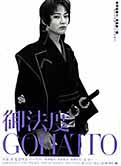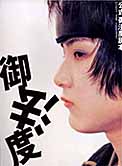|
|
|
|
TABOO
- GOHATTO
Reviewed
May 2001
Oshima
Nagisa
is thought by many to be the most
dynamic director of Japanese film since the legendary Kurasawa.
After a 14 year absence from film making, Oshima has once
again shaken the world of cinema with his latest breathtaking
work, Taboo (or Gohatto
in Japanese). Best
known in the West for directing In
the Realm of the Senses (an erotic masterwork that
was censored in Japan), and Merry
Christmas Mr. Lawrence (which starred David Bowie),
Oshima now offers us a dazzling period piece full of extraordinary
beauty and unrestrained passions.
|
|
Gohatto
is a romantic tale of love between samurai warriors, and
given the fact that Oshima, 68, has said of himself "I break
taboos, and I'm interested in people and actors who break
taboos", this samurai film is unlike anything that has ever
proceeded it. Set in Kyoto during the spring of 1865, the
film opens with the Shinsen-gumi militia choosing new recruits
to add to the ranks of their samurai warriors. Out of all
those who compete in a ferocious duel with the militia's
top swordsman, the cheerful but tough as nails Soji Okita,
only two are chosen, Tashiro Hyozo and Kano Sozaburo. The
moment the handsome young Kano entered the militia grounds
everyone took note of him as a bishounen (beautiful boy).
All were taken by the effeminate 18 year old warrior's bewitching
good looks, even those who did not have "that leaning."
It was as if a delicate porcelain doll had entered the world
of grizzled fighting men.
Hidden
desires took control when militia commanders Kondo Isami
and Hijikata Toshizo agreed to take in Kano, as much for
his devastating presence as for his skillfulness in handling
a sword. To test the young Kano's resolve, Kondo and Hijikata
decide to have the young recruit be the executioner of a
samurai who has broken the militia's strict rules. When
the doomed man is decapitated by an unflinching Kano, who
then ritualistically presents the head to his military commanders...
the leader Kondo falls in love with Kano for his "courage",
and Hijikata, disturbed by the young man's coldness, is
nevertheless oddly attracted to him. By this time, Tashiro
and Kano have settled into their austere surroundings, with
Tashiro professing his love for Kano and openly courting
the young samurai. Tashiro's passion is so overwhelming
that soon the entire militia comes to think of the two recruits
as lovers.
|
|
|
|
From
left to right, Soji Okita, Kano Sozaburo, and Tashiro
Hyozo. This image is a detail from the Japanese
Gohatto movie poster. Click the image to see the
entire poster.
|
|
But
the sexual intrigues are just beginning to develop. Other
high and low ranking samurai make overtures to the seductive
Kano, and soon the entire structure of samurai discipline
is thrown to the winds as various men, openly and secretively,
compete for Kano's affections. Throughout all this erotic
turmoil, Kano remains aloof and uncommitted to anything
save his life as a samurai.
|
|
One
is never quite sure if the mysterious Kano is actually
romantically involved with any of the militia men. He
seems to harbor some great secret, and only an occasional
disarming smile revels any emotion at all. At times he
seems innocent and boyish, even keeping the hair style
of an adolescent... some say, to intentionally provoke
sexual desire in men. Kano appears to enjoy all the attention
he receives, but his thoughts and motivations remain enigmatic.
|
 |
|
When
a member of the Shinsen-gumi militia turns up dead under
suspicious circumstances, the plot begins to thicken.
The militia commanders are aware of rival samurai who
want to undermine the Shinsen-gumi and challenged their
authority... but the commanders also fear and suspect
that the passions and jealousies of their own men regarding
Kano may have lead to deep divisions and foul play. The
way in which the commanders choose to resolve the dilemma
only
makes matters worse and leads to an almost total unraveling
of the Shinsen-gumi. I won't give the details away but
the plot twists and turns eventually come to an unexpected
and explosive culmination.
Oshima said almost playfully of his film, "I wanted to
surprise the Japanese public by choosing a work that was
slightly different." The audience is challenged by forcing
a reexamination of male sexuality, using as the focal
point that most macho of all Japanese figures, the samurai.
As the director put it in his own words, "On the question
of strictures against gay lovers in Japanese society,
I would say that historically it has been relatively lax.
Within this relatively lax situation, it in fact flourished."
Gohatto
is not just a masterfully told story about the human heart
and carnal desire. It's incredibly lavish set designs,
use of historic locations, heart stopping swordplay choreography,
and excellent costuming by Emi Wada, make for a visually
unforgettable film. Each scene's spectacular design is
surpassed by the next, with the ending moments of the
movie containing some of the most sublime and profoundly
beautiful images ever committed to film.
Fans of Japanese animation will immediately see a similarity
with the series Rurouni Kenshin,
or any other anime and manga title where bishounen are
central to the story.
All
of the actors give superlative performances. Matsuda Ryuhei,
the fresh young face who plays the part of Kano
Sozaburo,
is absolutely
perfect in the role of the irresistible bishounen. But
my favorite actor in the film is the ultimate tough guy,
"Beat" Kitano Takeshi,
who plays commander Hijikata
Toshizo. Beat has directed and starred in numerous Yakuza
(Gangster) films... his most recent being Brother,
making him one of the biggest stars in Japanese cinema.
His portrayal of the stoic and granite-like Hijikata,
torn between feelings for Kano and his sense of duty,
is a marvel to behold.
|
|
|
The
wonderful music for Gohatto was composed by Sakamoto
Ryuichi, and his purely instrumental score is understated
yet compelling. The composer embellished the tragic tale
of Kano with a brilliant sound track whose melancholy
theme song reoccurs throughout the film. It is a haunting,
heart breaking melody that captures the very essence of
the movie's temperament. Best known to American film buffs
for scoring the music to The Last
Emperor, Sakamoto first emerged in the 1970's as
part of the ground breaking Japanese art band, Yellow
Magic Orchestra.
|

|
|
|
|
The
rugged "Beat" Kitano as militia Commander
Hijikata
|
|
Gohatto
is one of the most unusual, poetic, and stirring films
ever to have been made, and it surely marks Oshima Nagisa
as the greatest living film maker in Japan today. Entered
in the Cannes Film Festival 2000, the film also enjoyed
a November theatrical premier in the United States.
Most
likely Gohatto will not receive wide acclaim in the
U.S. due to its controversial subject matter, but that
should not prevent film lovers from seeking out this
masterpiece from one of cinema's greatest mavericks...
Oshima Nagisa.
|
|